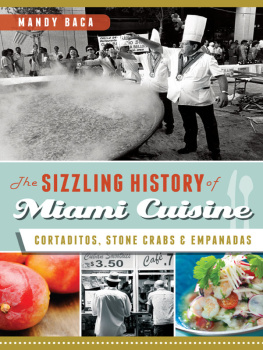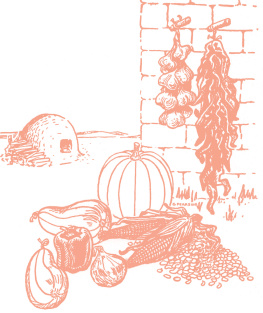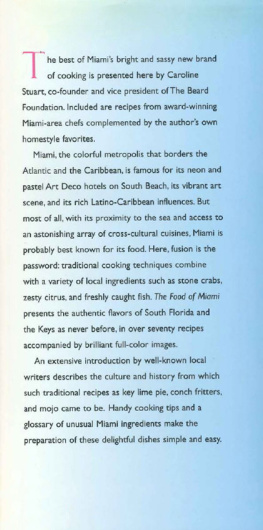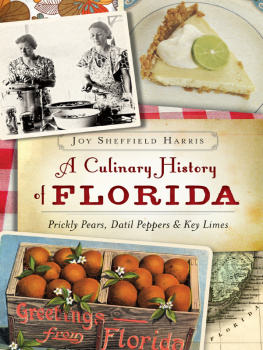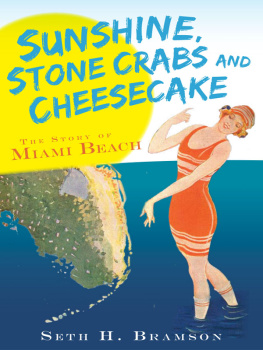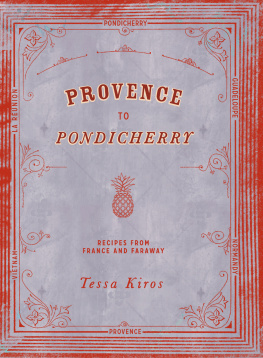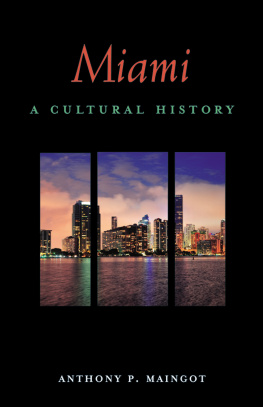
Published by American Palate
A Division of The History Press
Charleston, SC 29403
www.historypress.net
Copyright 2013 by Mandy Baca
All rights reserved
All photographs courtesy of the author unless otherwise noted.
First published 2013
e-book edition 2013
Manufactured in the United States
ISBN 978.1.61423.929.1
Library of Congress CIP data applied for.
print edition ISBN 978.1.60949.901.3
Notice: The information in this book is true and complete to the best of our knowledge. It is offered without guarantee on the part of the author or The History Press. The author and The History Press disclaim all liability in connection with the use of this book.
All rights reserved. No part of this book may be reproduced or transmitted in any form whatsoever without prior written permission from the publisher except in the case of brief quotations embodied in critical articles and reviews.
CONTENTS
INTRODUCTION
But the bright side is that Miamis optimism, coupled with its unique geography, has, over the course of its one-hundred-plus years, made it like nowhere else in Americaor rather North America.Scott P. Cunningham
Miami is a world all its own, and as poignantly mentioned above, like no other place in the country. Ask anyone what he or she thinks of Miami, and the following is conjured up:
Southern American (politically liberal, anti-big government) with strong Latino influence (and a lot of ultra-conservative Cuban ex-pats).
When I think of Miami, I think Latin American culture predominated by Cubans and mixed with a healthy elderly Jewish population.
Alligators, crazy people, sex, beach, Cubans and Europeans, tourists.
Ask anyone what constitutes Miamis cuisine, and youll hear the following:
The only thing I can come up with is rice, fish and lots of fruits, like pineapple. Also, theres a lot of beef consumption.
Miami cuisine equals Cuban plus other Latin American influences mixed with basic American.
Cuban with some Jewish items mixed in.
A lot of the above is true, but other parts feed into the negative stereotype that is often associated with Miami. Incorporated on July 28, 1896, Miami is a city that was created from the dreams of our forefathers from the cold North, who were looking for new land, new vacations and, most importantly, new dreams. They were looking for a new Naples, one could say, and if at the very least, a new Jersey Shore, which at the time of Miamis incorporation was considered Americas playground. In contrast to other cities that came to be out of necessity, Miami was created for the enjoyment of others. Why else would the early settlers willingly move to a fly-infested swamp that was, at the time, more isolated and dangerous than Perth, Australia? While Miami was incorporated in 1896, much later than the rest of the country, the area has a long and rich history of wars and diverse settlers, making it one of the earliest inhabited locations in what is considered the New World. Findings of pre-Columbian settlements in the area have been traced as far back as ten thousand years ago.
To dispel the preconceived stereotype, Miami is no longer just sun, sand and party. It is most recently an epicenter for fashion, arts and culture. Food-wise, Miami has flourished in the past thirty years, and world-renowned chefs and innovative cuisine have made it a permanent fixture on the worlds food map. It is now an important hub and a top contender when comparing the best food cities in America.
But how did we get here? And why do we eat the way we eat? There are hundreds of books about the history of Miami and hundreds of Miami and/or Florida cookbooks, but none that merge the two as a conclusive history of Miamis cuisine.
A popular quote amongst food lovers is that of separating those who eat to live from those who live to eat. For those that eat to live, its easy to write off food as nothing more than sustenance and the occasional form of entertainmenta necessary part of society and human interaction. Its also easy to forget that food is an evolutionary being that is not stagnant. Food history is important because it teaches us about a specific community and its evolution. In this case, Miami, a magic land for newcomers and the land of the transient, food is especially important, as it acts as a form of identity and helps with assimilation. It also provides an exceptional view of the progression of a cityits highs and lowsas well as its people.
A lot of history can read like a timeline, filled with dates and not very entertaining. In researching and reading history, the mundane always seems to take a backseat, and little details of the daily lives of common society were rarely recorded. In the present day, with the likes of Facebook, Twitter and Instagram, all of the intricacies and the banality of life are being recorded and will be forever stored in the realms of the Internet so that when the twentysomethings of this generation grow up, they can have a detailed view of what their life was like back in the 2000s. In the same fashion, I want this document to read like a storythe story of Miami through the lens of food and a compilation of the food stories throughout the centuries told by the people who lived them. To kick it off, here are a few stories from one of HistoryMiamis projects, Make Miami History Now, which is aimed at saving Miamis memories:
Shrimp cocktails on Key Biscayne at the Hurricane Harbor Lounge were $1.50, and Leonards La Pena on Bird Road served ONLY shrimp cocktail and steak. Whitey graciously showed you to your table at The Pub on Coral Way, where the lettuce wedge was huge. Sam & Carls Deli on Red Road was a favorite, too, serving a Messy Bessy Sandwich. A trip into Coral Gables netted you delicious pastry at Andalusia Bakery, and there was Woolworths and Jans for outrageous ice cream concoctions. Jimmys Hurricane on Bird Road, Chesapeake Oyster House in the Gables, and Perrine were popular restaurants.Molle Grad
My one grandmother would take us to Juniors on 79th Street and Biscayne Boulevard, where they had great breads and rolls. My other grandparents used to take us to the Roney Pub for dinner. We loved that big quarter-wedge of iceberg lettuce theyd give you with a choice of dressing. Wed also go to Corkys for pastrami and corned beef back in the days when I ate big, meaty sandwiches. Corkys used to have a drive-up area where you could order from your car window, and theyd bring your food out to your car and hook a tray to your car window.Jody Collins
I worked as a hostess at Maisels Restaurant, then known as Juniors, on the corner of 79th Street and Biscayne Boulevard. Having come from up north, I could not believe that the restrooms and water fountains were segregated; White and Colored signs were placed on them. This restaurant, like Wolfies, was very popular. We used to have long lines.Loretta Barish Morris
Having lived in Palmetto Bay for over 30 years, I have many memories, such as dining at Black Caesars Forge on the corner of 152 Street and 67 Avenue, famous for their potatoes baked in a tree resin. We also had land crabs the size of a small dinner plate running through our yard. It was impossible to drive 152 Street without running over them. I never see any large ones anymore; once in a while, a few small ones appear.Annita DeWitt Middleton
Miami in the Miami Vice eighties was glamorous, fast-paced, and a little scary. Still, I enjoyed going to clubs such as Cats, Suzannes, The Mutiny, and Faces in the Grove. One night, while at Biscayne Babies, my sisters and I even met Senator Ted Kennedy
Next page
